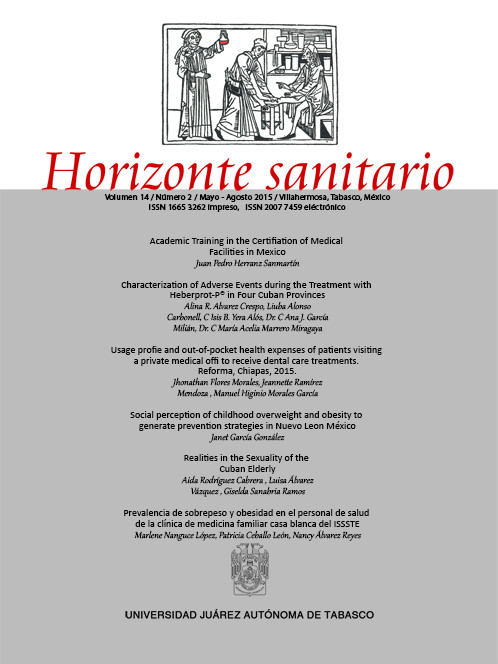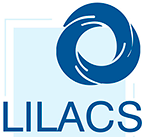Characterization of adverse events during the treatment with heberprot-p® in four cuban provinces
DOI:
https://doi.org/10.19136/hs.a14n2.950Keywords:
Adverse drug reaction, Pharmacosurveillance, Diabetic foot ulcerAbstract
Objective. The objective of this study and the reason that encouraged us to carry out this work was to characterize the adverse events reported during the treatment with Heberprot-P® in diffrent health institution/centers. Materials and Methods: Longitudinal, multicenter, postmarketing follow-up study of Heberprot-P®. Intensive surveillance was used as PS (pharmacosurveillance) method. The following variables were considered: presence or absence of AEs (adverse events); most frequently reported AEs; affcted organ system; serious AE according to cause conditioning both the event severity and type, and severity of ADRs (adverse drug reactions) and causality of AE reported as serious. Results: The presence of at least one AE was reported in 260 patients (59.1%). Burning sensation and pain in injection site, chills and shivering, were the four most frequently reported adverse events. A total of 11 events were identifid as serious. Conclusions : The intensive PS of the drug should be continued since all the routine medical practice data that could be contributed are essential for the purpose of enriching the drug’s safety profieDownloads
References
Organización Mundial de la Salud. Lafarmacovigilancia: garantía de la seguridad en el uso de los medicamentos. Perspectiva política de la OMS sobre medicamentos. Ginebra: OMS; 2004.
Laporte J.R. El Ensayo Clínico Controlado. En: Principios básicos de la investigación clínica. 2da ed. Barcelona: AstraZeneca; 2001: 28-51.
Marletta L. Aspectos Regulatorios de los productos biológicos/biotecnológicos, Argentina 2008. [Citado 30 de mayo de 2015]; Disponible en: http://www.ebebiopharma.org/forcedownload.php?file=/media/biosimilars/biosimilar
Fernández-Montequín JI, Infante-Cristiá E, Valenzuela-Silva C, Franco-Pérez N, Savigne-Gutierrez W, Artaza-Sanz H, et al. Intralesional injections of Citoprot-P_ (recombinant human epidermal growth factor) in advanced diabetic foot ulcers with risk of amputation. IntWound J. 2007; 4:333–343.
Colectivo de autores. Experiencia Cubana en la extensión del uso del Heberprot -P. En: Fernández-Montequín J, Berlanga Acosta J, López Saura PA, López Mola E, Herrera ML, YeraAlós I, et al. Infiltración del Heberprot-P. La Habana. Ed.ElfosScientiae; 2009:100-106.
Karch FE, Lasagna L. Toward the operacional identification of adverse drug reactions. Br J ClinPharmacol 1977; 21(3):247-254.
Armijo J, González Ruiz M. Estudios de seguridad de medicamentos: Métodos para detectar las reacciones adversas y valoración de la relación causa-efecto. En: El ensayo clínico en España. 2002; 161:190.
Centro para el Desarrollo de la Farmacoepidemiología. “Normas y procedimientos de trabajo del sistema cubano de farmacovigilancia”.2007. [Citado 30 de mayo de 2015]. Disponible en: http://www.cdf.sld.cu/fv/NormasyProcedimientos2007.htm.
Uppsala Monitoring Centre. 2010 October [Citado 30 de mayo de 2015]; Disponible en: http://www.who-umc.org.
Domínguez Caballero JL.Evolución clínica y seguridad del Factor de Crecimiento Epidérmico Humano Recombinante en pacientes tratados en las provincias centrales Cuba2007-2009”[tesis]. Centro para el Desarrollo de la Farmacoepidemiología; 2010.
Llanes Barrios JA; Fernández Montequín JI; Seuc AH; Chirino Carreño N; Hernández Rivero MJ. Caracterización del pie diabético y algunos de sus factores de riesgo. Rev Cubana AngCirVasc[serial onthe Internet]. 2010 [Citado 15 de enero de 2015]; 13(2): [p.10-18] Disponible en: http://bvs.sld.cu/revistas/ang/vol11_01_10/ang02110.pdf
Hernández Rivero MJ, Llanes Barrios JA, Acosta Lapera DS. Heberprot-P, una terapia eficaz en la prevención de la amputación en el pie diabético. Rev Cubana AngCirVasc[serial onthe Internet]. 2009 [Citado 15 de enero de 2015]; 10(1): [p. 3-11]Disponible en: http://bvs.sld.cu/revistas/ang/vol10_1_09/ang02109.pdf
Kushikata T, Fang J, Chen Z, Wang Y, Krueger JM. Epidermal growth factor enhances spontaneous sleep in rabbits. Am J Physiol 1998; 275:509-514
Fernández-Montequín JI, Betancourt BY, Leyva-González G, López Mola E, Galán-Naranjo K., Ramírez-Navas M, et al. Intralesional administration of epidermal growth factor-based formulation (Heberprot-P) in chronic diabetic foot ulcer: treatment up to complete wound closure. IntWound J. 2009; 6(1):67–72.
Gil RM, López Mola E, Álvarez H, Hernández A, Pérez C, Yera I, et al. Experiencias en la extensión nacional del programa de atención integral al paciente con úlcera del pie diabético y el empleo del Heberprot-P. RevBiotecAplic. 2010;27(2):142-146.
González Acosta S, Calaña González-Posada B, Marrero Rodríguez I, López FernándezR. Evolución clínica del tratamiento en el pie diabético con Heberprot-P o con el método convencional. Rev Cubana AngCirVasc [serial onthe Internet]. 2011 [Citado 15 de enero de 2015]; 11(2): [8 p.]
Disponible en: http://bvs.sld.cu/revistas/ang/vol_11_2_11/ang07211.htm
Velázquez W, Valles A, Curbelo W. Impacto del Heberprot-P® en el tratamiento de las úlceras de pie diabético. RevBiotecAplic. 2010; 27(2):129-135.
Ramírez Calzadilla Y. Evolución clínica y seguridad del Factor de Crecimiento Epidérmico Humano Recombinante en pacientes tratados en Holguín, Granma y Santiago de Cuba. Cuba. 2007-2009”[tesis]. Centro para el Desarrollo de la Farmacoepidemiología; 2010.
Grossman E, Messerli FH. Diabetic and hypertensive heart disease. Ann InternMed 1996;125:300-310.
Crespo Mojena N, Martínez Hernández A, Rosales González E, Crespo Valdés N, García Roura J. Diabetes mellitus e hipertensión: Estudio en el nivel primario de salud. Rev Cubana Med Gen Integr [revista en la Internet]. 2002 Oct [Citado 15 de enero de 2015]; 18(5):331-335.Disponible en: http://scielo.sld.cu/scielo.php?script=sci_arttext&pid=S0864-21252002000500007&lng=es.
Mor Bach S, Lutale JK, Viswanathan V. Regional differences in diabeticfootlesions.DiabetMed 2004;21(1):81-85.
Campbell PT, Newton CC, Patel AV, Jacobs EJ, Gapstur SM. Diabetes and cause-specific mortality in a prospective cohort of one million U.S. adults. Diabetes Care 2012; DOI: 10.2337/dc12-0002.
Centro para el Desarrollo de la Farmacoepidemiología. Formulario Nacional de Medicamentos. Información del producto Heberprot-P. La Habana: Ciencias Médicas; 2006. [Citado 15 de enero de 2015]; Disponible en: http://fnmedicamentos.sld.cu/index.php?P=FullRecord&ID=648





























